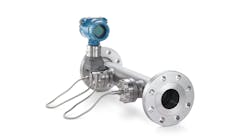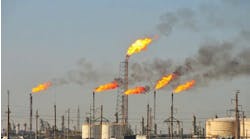Hydrogen is a sustainable fuel solution that is quickly gaining traction in the global marketplace. Hydrogen dispensing requires the utmost safety parameters to ensure risk are mitigated. That is especially true for one of hydrogen’s primary potential uses, which is serving as a fuel source for vehicles.
Emerson is on the forefront of measuring hydrogen dispensing efficiently thanks to one of its newest products, the Micro Motion High-Pressure HPC020 Coriolis Flow Meter, which is set to debut in March.
Genny Fultz, global product manager for Emerson, talked with Control about the new unit, the increasing market interest in hydrogen, the challenges facing hydrogen dispensing, and the safety and benefits of the HPC020 Meter.
A: We have found that there is a market for filling larger commercial and passenger vehicles at a faster rate to keep up with the diesel truck industry. But in addition to dispensing those applications, we've also found that there's a need for loading tube trailers. The loading and offloading point within the hydrogen transportation value chain is something that we've been looking into quite recently. With that in mind, the design of these HPC sensors, specifically the HPC020 reflects those changes in the market by utilizing sensor components that are slightly different than the HPC015 and that allow for a higher flow rate while keeping the batch accuracy at 0.5%.
Q: There are also some challenges in metering hydrogen, especially with regards to temperature, pressure and accuracy. Can you speak to that?
A: Hydrogen offers a pretty great opportunity to fuel vehicles of all different types and sizes. Like other gaseous fuels, it can be compressed and kept at high pressures to be used into that single fueling. The flowmeter uses the batch fueling process, and it needs to remain accurate over that fill. A wide variety and dynamic range of conditions, including pressures exceeding 10,000 psi, is crucial so that it is able to perform at -40 C all the way up to 60 C, and these are ambient temperatures. It's something to keep in mind with a flow meter. Coriolis technology offers the best solution for those types of metering needs.
Q: Hydrogen leaks can be a very serious safety hazard. How does the HPC020 protect the safety aspects of the dispensing operation?
A: One thing to note about the Coriolis sensors is that they're well suited for these types of applications because of their completely welded assembly. The Micro Motion sensor is a fully welded assembly, meaning that the only connections are the inflow and outflow of the meter. The HPC015 and HPC020, use hydrogen embrittlement-resistant materials. Those materials are XM-19, which is an austenitic stainless steel commonly used in aviation and nuclear industries when working with hydrogen-related fuels. It has nearly twice the strength of 316 L, and it’s a pretty good choice when working with the higher pressures necessary when refueling hydrogen cars or large trucks.
Another benefit to using a Coriolis sensor is that they're extremely reliable. We have this phrase that you install it, you set it, and forget it. Once the sensor's been installed in the field, the likelihood of that meter ever needing any kind of maintenance is very low. That eliminates the need for anyone to open the dispenser to check the flow meter, and reducing those touchpoints is another way of improving safety in the field.
A: Yes, in addition to not requiring regular maintenance, they don’t require any yearly replacement components like some other technologies do. The sensors are designed to be installed and left alone to work. We also offer Smart Meter Verification, Emerson’s proprietary diagnostic software that uses onboard diagnostics with the flow transmitter. It continuously monitors those key performance indicators that maintain measurement and accuracy and meter integrity. Over long-term, this reduces costs through early detection of any issues that you could possibly have in your dispensing process.
Q: Can you tell us about the flow rate and pressure capabilities of the HPC020?
A: There are two available models with different flow rates and pressure capabilities. The HPC020 M sensor is designed for a 700-bar system that flows at a little bit higher rate, at 9 kilograms per minute nominal flow rate. And the HPC020 N sensor is designed for a 700-bar system that has an additional safety pressure requirement. That pushes that pressure rating higher than the M model, while flowing at a reduced nominal flow rate at 7.7 kilograms per minute. They both have the same face-to-face dimensions on the exterior of the sensor, like the case and connection points are all the exact same dimensions, but the difference comes down to the material components within the sensor that allows for those pressure rating and nominal flow rate differences. With the addition of the new HPC020, Emerson now has a full hydrogen dispensing portfolio that will help any customer in their hydrogen dispensing operations, whether they want to fill a semi or a passenger car.
To learn more about the new Micro Motion High-Pressure HPC020 Coriolis Flow Meter visit emerson.com/micromotionHPC





